A municipal budgetary educational institution gymnasium №1
Topic: Airport of the future – ideas of realization.
Section of the English language
Research work
Made by: Zlydar Arina Vitalievna,
a student of class 10 «A»
The project manager is:
Kostyleva Marina Vyacheslavovna,
English teacher
Khabarovsk city
2022
CONTENT
Introduction. 3
Main part. Airport of the future – ideas of realization. 4
Chapter 1. Old airports. 4
Chapter 2. Ideas of realization of new technologies at airports. 6
2.1. New ideas the implementation of airports of the future. 6
2.2. «Hot» trends. 8
Chapter 3. Ideas of realization of new airports. 10
Chapter 4. The practical part. Peer survey. 14
Conclusion. 19
List of links. 20
Additions 21
Introduction.
Nowadays people travel a lot. One of the most common modes of transport is an airplane. Therefore, people visit airports quite often and sometimes spend a lot of time there. But, unfortunately, not all airports can provide comfort for travelers, and I consider this a problem. This problem is gradually being solved and airports are being rebuilt. I'm going to analyze ideas about the implementation of such plans in my project. Moreover, I want to connect my future with airports and dream of becoming an air traffic controller, thereby I believe that working on this project is as useful and interesting as possible.
The purpose of this research work is to analyze ideas about the implementation of new airports.
To achieve this goal, it is necessary to perform the following tasks:
1. Consideration of the oldest airports in the world.
2. Study of existing ideas the implementation of the airport of the future.
3. Conducting a survey among peers on the subject of their knowledge of new technologies in the airports of the future.
4. Summarizing information and getting a conclusion.
In working on the project, I use the following research methods:
1. Thinking.
2. Systematization and generalization of ideas.
3. Survey.
The subject of the study is the airport of the future.
The relevance of the project is the systematization and generalization of information about airports, which can later be used in career guidance lessons, thereby widening the horizons of students and increasing interest in professions related to aviation infrastructure.
Main part. Airport of the future – ideas of realization. Chapter 1. Old airports.
In this chapter, I would like to tell you about the oldest airports in the world, which brought a person closer to the realization of his beloved dream - to surf the heavenly spaces like birds and left their mark on history.
«Hamburg» is the oldest airport in the world, located in Germany (addition 1), still receiving commercial flights. It was opened in January 1911, and today it is one of the five busiest airports in the region [2].
Bucharest Banias International Airport named after A. Vlaicu in Romania (addition 2) was opened in 1912. Until 1968, it was the only airport in Romania, today it is the second busiest: the championship went to the Henri Coanda International Airport, where most international flights arrive [2].
Don Muang International Airport in Thailand was opened on March 27, 1914. Until 2006, when Suvarnabhumi was launched, Don Muang was the main airport of the country [2].
Rome-Ciampino Airport in Italy (addition 3) was opened in 1916. The oldest airport in Italy was named after the famous pilot of the First World War, but it is usually called simply Ciampino. Today, Ciampino is mainly focused on internal and charter flights. Leonardo da Vinci Airport in Fiumicino was opened for international flights in 1960. In addition, airlines with cheap tickets fly here, which fly relatively short distances, thanks to which Ciampino has become one of the busiest and fastest-growing airports in the country. Passenger traffic here is about 5 million people a year [2].
Schiphol Airport, Netherlands (addition 4). Amsterdam's main airport and Europe's most important gateway, Schiphol began its history on September 16, 1916, when there was a military airbase. Civil aircraft began arriving in Schiphol in 1920, when it was still called Schiphol-les-Bains. There is only one terminal in Schiphol, but it is huge: it ranks 16th in the list of the largest buildings in the world by area [2].
Khabarovsk International Airport (addition 5), which is called "New", was opened in 1954. Until now, it is the only effective international terminal in Khabarovsk [2].
As we can see, there are a large number of airports built in the last century and still operating. Many of them are already being reconstructed and made more comfortable to stay there. But there are also old airports that are not being rebuilt at the moment, but new projects are preparing to create airports of the future that are as comfortable as possible for a modern person. I will analyze them further.
Chapter 2. Ideas of realization of new technologies at airports. 2.1. New ideas the implementation of airports of the future.
According to the International Air Transport Association, the number of passengers should double in the next twenty years, but the process of airport expansion will not be as swift [1]. And passengers quite rightly want all processes inside the airport to be carried out without any problems. The only way to ensure the smooth operation of air harbours is to develop and apply new technological decisions that increase the efficiency of their work and the quality of passenger service.
According to the forecast of IATA (international air telecommunications’ company), over the next decade, the passage of the control zone will turn into a walk along the corridor. You will no longer need to take off your coat, shoes, and belt, put small bottles in small bags. Queues will also be a thing of the past. The recognition system for passengers and their luggage will be triggered automatically when passing through the improved checkpoints. The rigid control zones will be replaced by «smart» sensor corridors, which will make the verification of paper documents outdated [1].
Each category will have its own tags: for passengers, luggage, or cargo. All this will be monitored throughout the journey, despite the type of transport used. This means that it will be possible to obtain a travel permit and pass customs checks even before arriving at the airport, which will significantly save time. At the same time, the remote baggage drop-off service will be offered where it is most suitable for the passenger, for example, at train stations [1].
In the era of connected airports, cheaper sensors, less specialized equipment, and new cloud data services powered by devices over 5G will be used. Data collection will be carried out through software-defined networks, then the information will go through the stage of comparison and analysis. This method will increase the efficiency of the airport and help make it much more convenient for passengers [1].
In addition, a quick trip to the airport and an unhindered passage of all stages of verification on its territory will make some previously profitable services, such as parking, unclaimed. Thus, airports need to find new ways to increase comfort. A personalized approach can help with this. It will provide passengers with the desired service at any time at every stage of the journey, and not just at the airport. For example, the limousine service provided at the airport, which also includes baggage check-in at home, office, or hotel, plus simplification of border control procedures for regular air travellers [1].
2.2. «Hot» trends.
One of the most popular technologies of the future at airports can be called biometric identification of passengers. It can be used at different stages: for example, to register passengers for a flight by selfie, when passing border control, when boarding. The realization of the "face as passport" concept can speed up these processes and increase the capacity of airports [1].
The countries that have already made the most progress in the use of passenger biometrics include the United States, where the regulatory framework allows you to try the most advanced innovations. In the summer of 2017, for example, JetBlue, together with Logan International Airport in Boston, began testing a biometric identity verification system for passengers at the boarding gate, freeing them from the need to present documents [1].
The introduction of biometric identification of passengers is gradually underway in Europe. In Italy, for example, 3 airports are in Rome, Bologna and Naples have introduced biometric passport control [1].
In Russia, the first steps are still being taken at airports to use biometric identification of passengers. At the same time, such technologies are already widely used in Russian airports to control internal security [1].
Robotics is also one of the technologies that are beginning to find wide application at the airport. For example, they can take passengers' luggage right at the entrance to the airport. Such a robot, developed by SITA, is being tested by the airport in Geneva (addition 6). It allows passengers to scan their boarding passes themselves, put the bags in the cargo compartment of the robot and attach tags printed by the robot to them. After that, the robot closes its cargo compartment so that no one can damage the luggage on the way to the loading station, where people will transfer the luggage to the conveyor strap [1].
A robotic terminal opened at Singapore Airport in the summer of 2018 (addition 7). Automated check-in counters and baggage belts, passport control with facial recognition technologies is available to passengers. The airport also has innovative baggage scanners that do not require putting laptops and phones out of hand luggage. Robots at this airport also work as cleaners [1].
Robotic technology is also used in Russian airports. So, in September 2018, testing of a robotic temporary luggage storage warehouse was completed at Moscow Domodedovo Airport, which should provide additional safety and accuracy when delivering passengers' luggage to the flight. Robots find the right tray in two minutes after receiving the command and transport the bag to the place of the flight configuration [1].
There are interesting perspectives for the use of blockchain technology at airports. Blockchain is a distributed database that stores information about all transactions of system participants in the form of a "block chain". It can be used for a wide range of purposes: from the passenger identification process to ticket sales, baggage tracking and managing frequent flyer programs [1].
In the summer of 2018, Brussels Airport launched the Freight Management App, a blockchain application designed to track the movement of cargo at every stage of delivery: from loading and unloading operations to freight forwarding. The Brussels airport expects that the use of blockchain will allow to fully digitize information about logistics, move away from manual processes of filling in the documentation for the import of products, as well as increase transparency and efficiency [1].
Chapter 3. Ideas of realization of new airports.
The existing development of large airports is more like the execution of the concepts of the cities of the future. Modern airports seem to have included all the wildest fantasies about futuristic cities of the XX century, and even outperformed them in terms of architecture.
Airports such as Denver (USA), Schiphol (Netherlands), Frankfurt and Munich (Germany), Doha (Qatar) and others are building full-fledged residential quarters close to the terminals to meet the housing needs of their employees, representatives of international companies, students at flight schools, as well as residents of neighbouring cities doing international business. Such airports are large businesses that have a positive impact on the economy of the region and nearby cities by creating new jobs, attracting large companies, providing a higher degree of mobility, building new infrastructure, and so on [3].
According to predictions of various international organizations, the global passenger traffic will grow to 6 billion people a year by 2030. In this regard, airports are aimed to increase infrastructure and develop as urban-planning entities in order to meet the need for mobility and the level of service of modern society. According to existing estimates, there are more than a hundred potential aerotropolis in the world that are at different stages of development, and in countries such as Qatar, the Arab Emirates, Turkey, new world's largest air hubs are already being built. Moreover, the passenger traffic of such airports is usually many times higher than the population of the country itself [3].
So, let's look at the main ideas about the concepts of modern airports.
A group of German researchers at the Bauhaus Aviation Institute, together with the Glasgow School of Art, developed a concept of a multi-level and relatively compact airport (addition 8) for an urban environment where the runway is located on the roof of the complex, and all public and technical premises are located on the levels below. The project offers a small air hub designed only for short-haul aircraft with a capacity of up to 60 passengers, which could be in the centre of a busy metropolis and would provide fast communication between cities by analogy with a regular train station [3].
Another project was developed at the Netherlands Aerospace Centre under the leadership of Henk Hesselink (addition 9). Its concept is based on the idea of building a circular runway or "endless runway". Theoretically, such a geometry could provide the necessary length for takeoff and landing, the ability to take off and land from either side of the runway, depending on the wind direction, would make it easier to break due to centripetal force. It is noteworthy that a few years earlier, a similar concept of a round airport was proposed by a student at the University of Sciences of Malaysia [3].
The most common concept of a modern multi-purpose airport is better known as aerotropolis. The idea of an aerotropolis as an urban-type infrastructure emerging around an airport was first described in 1977 by the founder of the Site Selection magazine McKinley Conway in the book "Airport city and the future intermodal transportation system". But this concept was more widely spread thanks to John D. Kasarda, a specialist in the development of Aerotropolis, who since the late 1980s has been researching this topic, popularizing, and consulting the largest airports, which, by the way, includes Moscow Domodedovo Airport. In 2011, together with Greg Lindsay, he published the book "Aerotropolis. The way we’ll live next", which describes in detail the existing trends in the development of airports around the world, which actually lead to the growth of the airport as a city [3].
Aerotropolis is a large airport (with a passenger flow of more than 30 million passengers per year), focused on increasing the number of non-aviation revenues by creating a multifunctional infrastructure, including hotels, shopping centres, business centres, offices, entertainment, sports and wellness centres, recreational areas, public spaces, parks, squares, as well as a full set of services and services. Such an airport is not just a transport hub, but also a business and regional centre that attracts not only users of transport services, but also residents of the surrounding area who use its infrastructure to meet the needs for business, leisure, and recreation [3].
Examples of the most developed aerotropolis include Atlanta Hartsfield-Jackson, Singapore Changi, Amsterdam Schiphol, Dubai Al Maktoum and others. By 2025, a new residential area "Aviacity" is being built at Frankfurt Airport, which is part of the Gateway Gardens complex with a business centre, housing, a wellness centre, kindergartens, shops, and other necessary services, designed for about 18 thousand people. The whole territory of the residential area in the immediate vicinity of the airport is designed for 81 thousand people and provides all the "urban" infrastructure, including university, workstations, banks, exhibition centres and others [3].
The future development of Munich Airport also includes the creation of a residential area with an aviation academy, flats, hotels, offices and leisure facilities. Fairs and exhibitions are regularly held at the airport, an ice rink, tennis courts, a surf pool (depending on the season), shops, cafés, restaurants are located. One of the goals set by the airport management, according to the brief, sounds like "creating public spaces with a unique atmosphere conducive to holding various events and creating public relations" [3].
The Singapore Air Hub has been ranked first in the ranking of the best airports in the world since 2013. It houses Jewel Changi Terminal, which opened in 2019. The terminal is a complex with entertainment activities, public spaces, gardens, waterfalls, shops, various services and services. Thus, from staying at the airport, a passenger can get an experience similar to visiting a museum, an entertainment centre or a tourist attraction [3].
Chapter 4. The practical part. Peer survey.
In the process of working on my project and diving into this topic, I had a number of questions:
« Is this topic interesting to my peers? »
« Do they know anything about the history of airports, about new technologies for creating airports of the future? »
« Are they familiar with modern terms in this sphere? » and so on.
Having asked these and other questions, I decided to take a survey using a Google form among students in grades 9-11, the main purpose of which was to get answers to my questions. I interviewed 100 students of MBOU Gymnasium №1.
So, let's look at the questions and the answers.
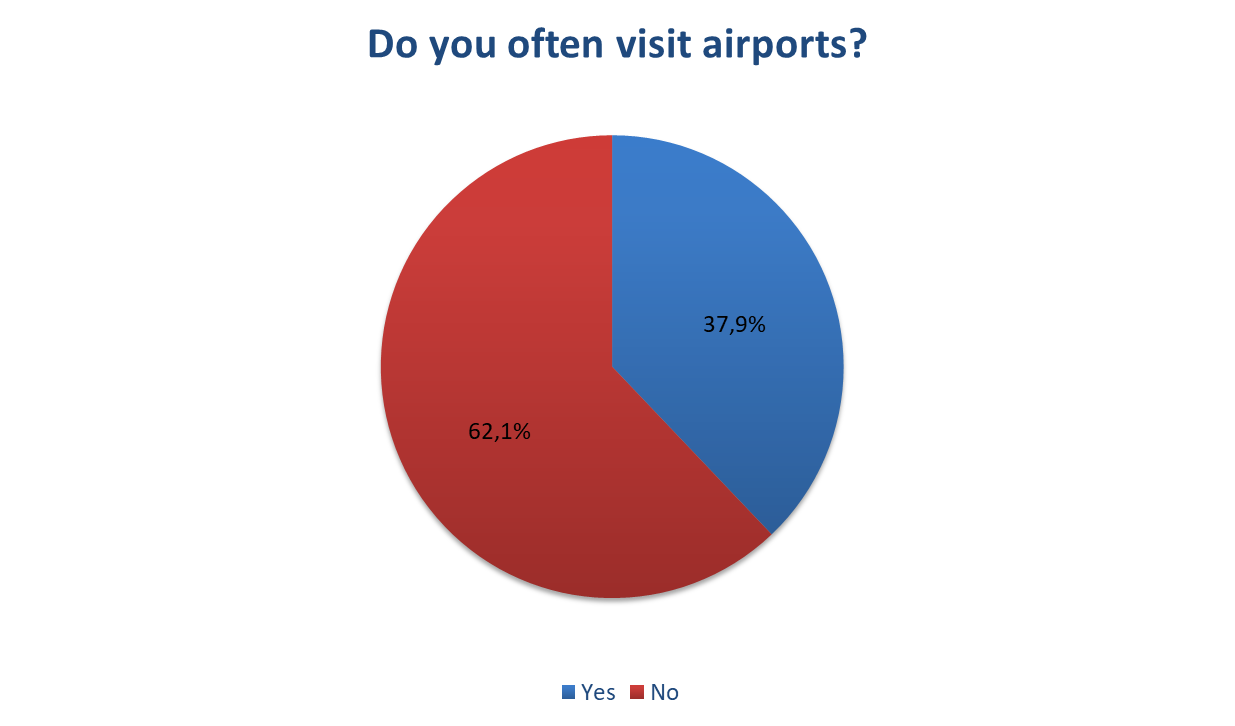
In this pie chart we can see that more than half of teenagers are not often visit airports.
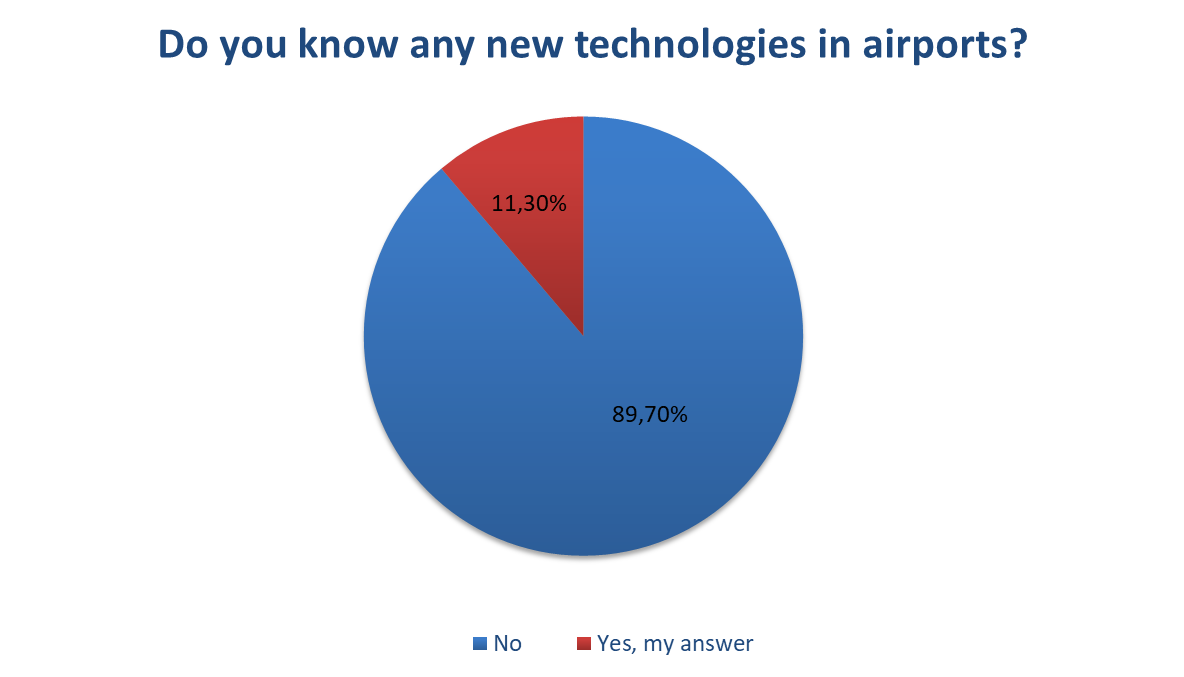
According to the pie chart, the majority of teenagers do not know new technologies in airports.
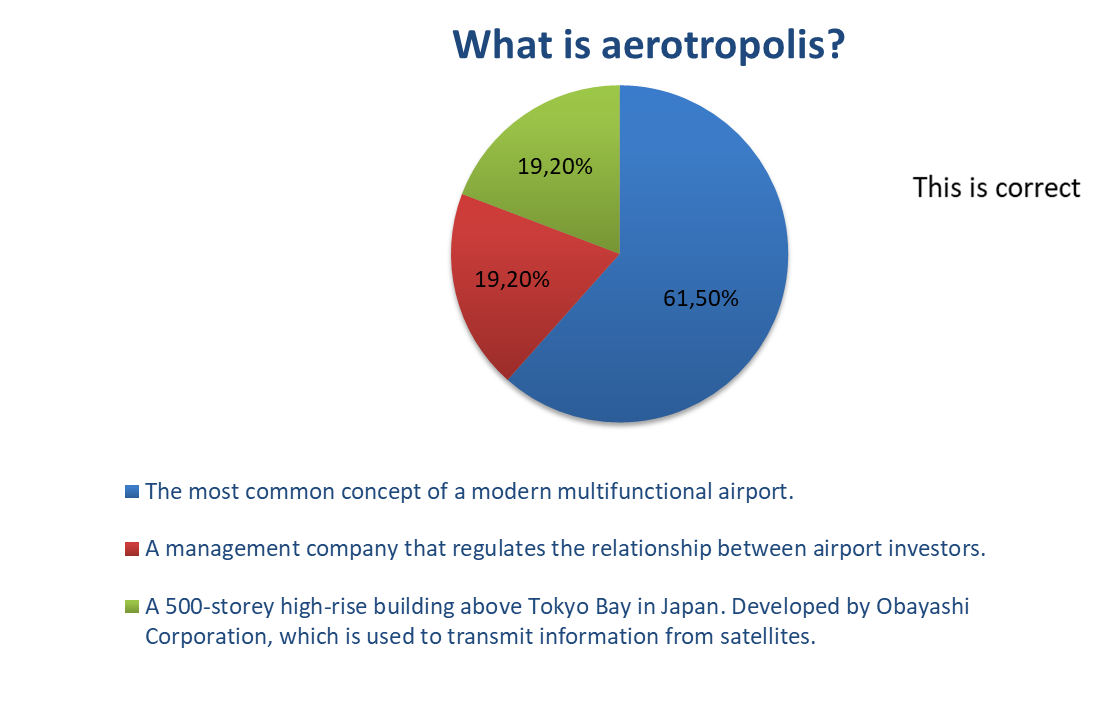

As we can see in the pie chart, mostly people know what is aerotropolis.

Here we can see, that the majority of teenagers know what is blockchain.
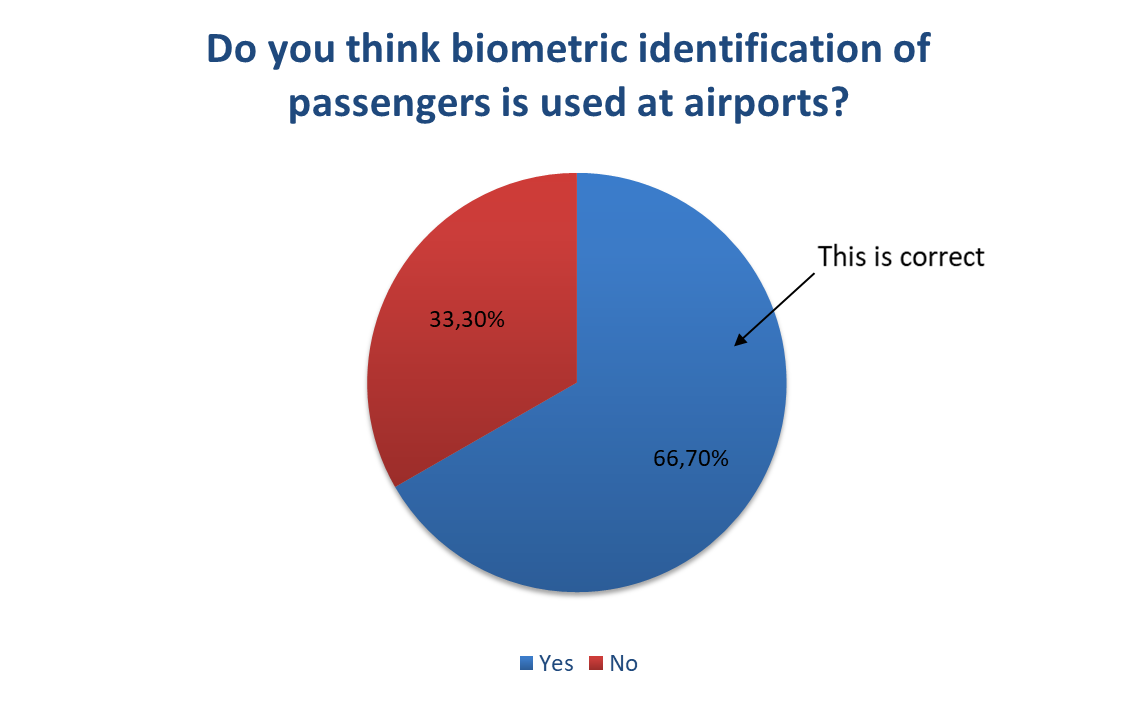
According to the pie chart, the majority of teenagers know information about using biometric identification in airports.
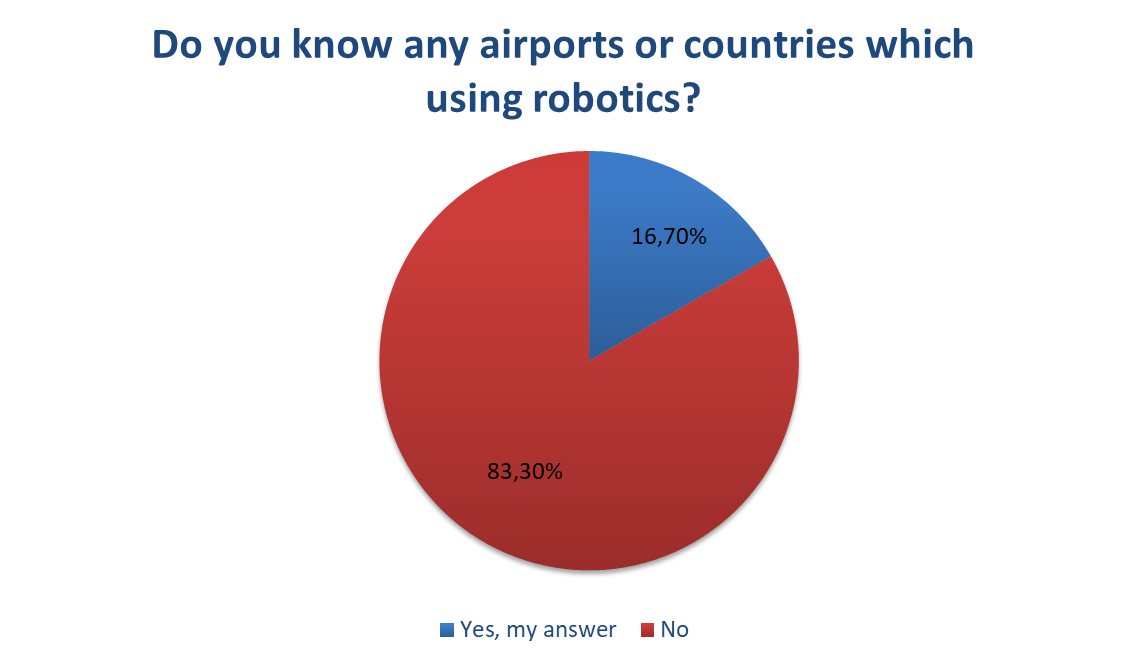
As we can see in the pie chart, the minority of teenagers know information about using robotics in airports in different countries.
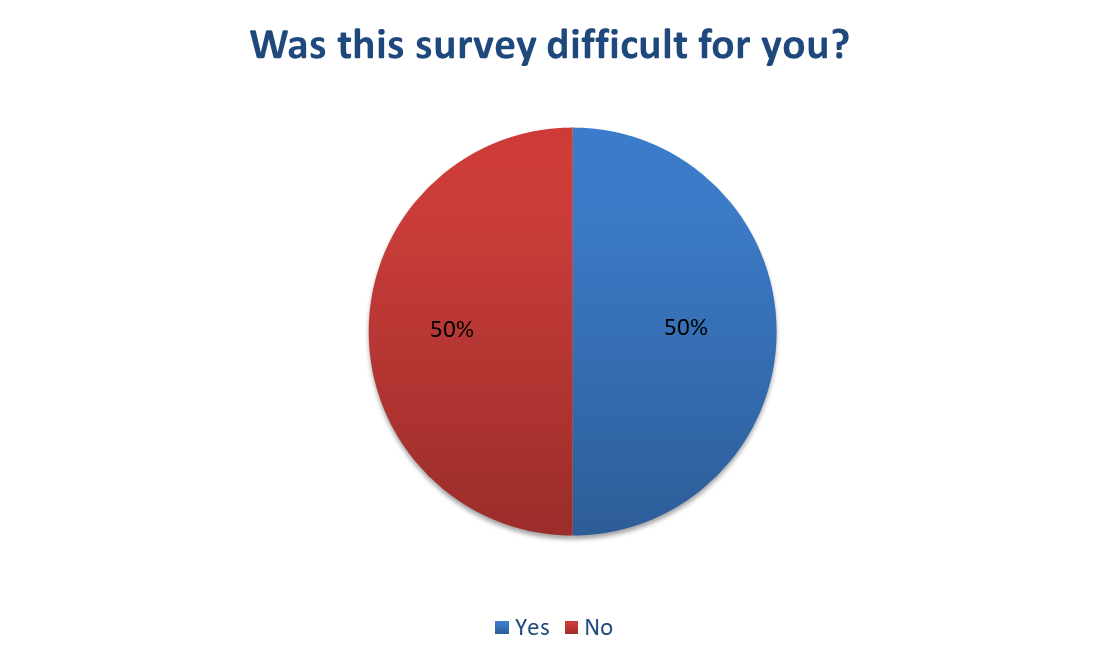
Here we can see, that only half of teenagers answered that survey had not been difficult for them.
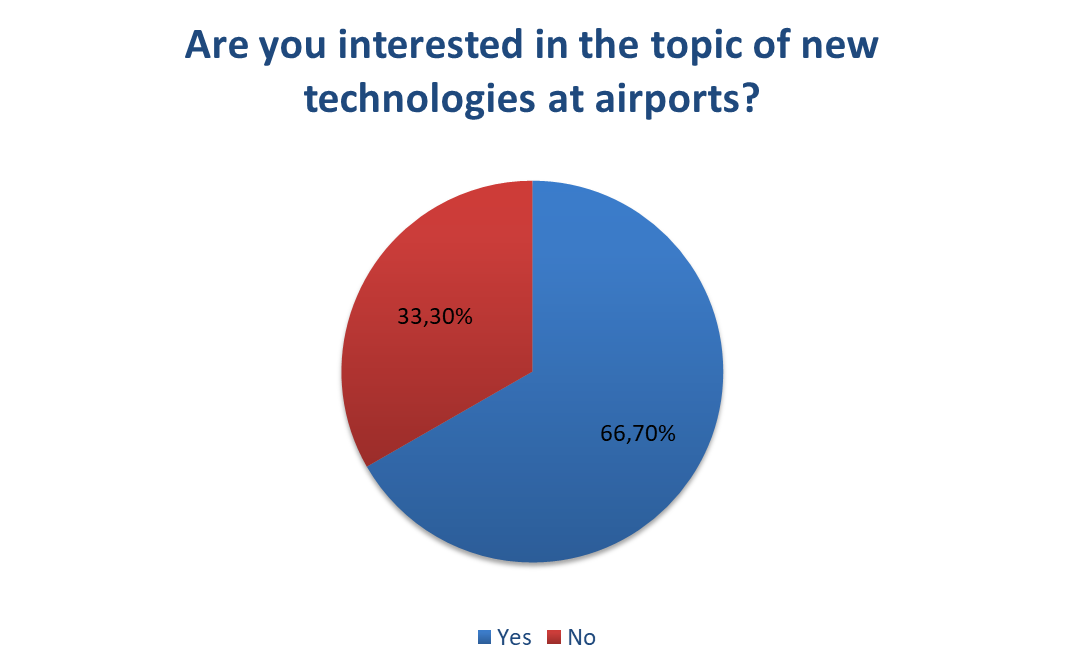
According to the pie chart, the majority of teenagers are interested in this topic.
So, after analyzing all the answers received from the students of the gymnasium, I can say with confidence that the topic of my project is relevant, because it affects a sphere with which the guys are practically not familiar. Thanks to my project, you can learn about the first airports in the world, about the history of their development, about new technologies that are actively used in modern airports to create the most comfortable conditions for passengers, which will certainly broaden the horizons of students and increase their interest in the field of activities related to aviation infrastructure.
Conclusion.
In my project I considered the oldest airports in the world, different ideas of implementation of new airports, «hot» trends such as biometric identification of passengers, blockchain and robotics and I took the survey among teenagers. I think my project is useful because from survey it is interesting for teenagers.
To consider, I can say that the development of airports is driven by economic and social reasons, and its infrastructure presents ample opportunities for multifunctional development. For developing countries and for Russia, including, the creation of an effective aviation communication network can be a serious impetus for economic growth, increasing connectivity and manageability of the territory. As world experience shows, the largest air hubs are becoming quite independent centres of economic and social activity, providing support to the largest cities and the surrounding region.
But aviation, unlike other modes of transport, does not tolerate breakthrough and radical changes. Each technical improvement, before it is implemented in a production aircraft, must undergo long and thorough tests. The fact is that, although aviation is considered one of the safest types of transportation, the cost of error in it is significantly higher than in road transport.
List of links.
1. https://news.myseldon.com/ru/news/index/220843125
2. https://zen.yandex.ru/media/onetwotrip/top5-samyh-staryh-aeroportov-mira-iz-kotoryh-do-sih-por-letaiut-samolety-5bbb29c7e27ae900aab18eb2
3. https://tatlin.ru/articles/novyj_urbanizm_aeroport_kak_gorod_budushhego
Addition 1
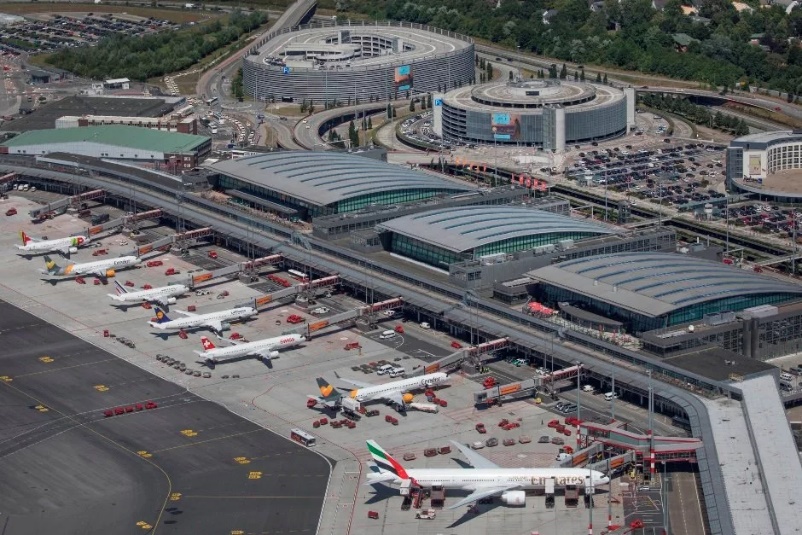
Addition 2
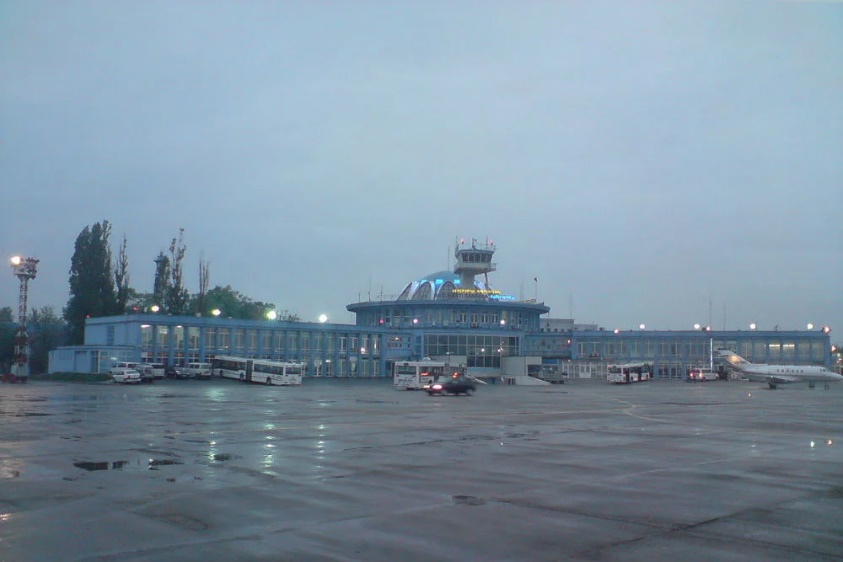
Addition 3
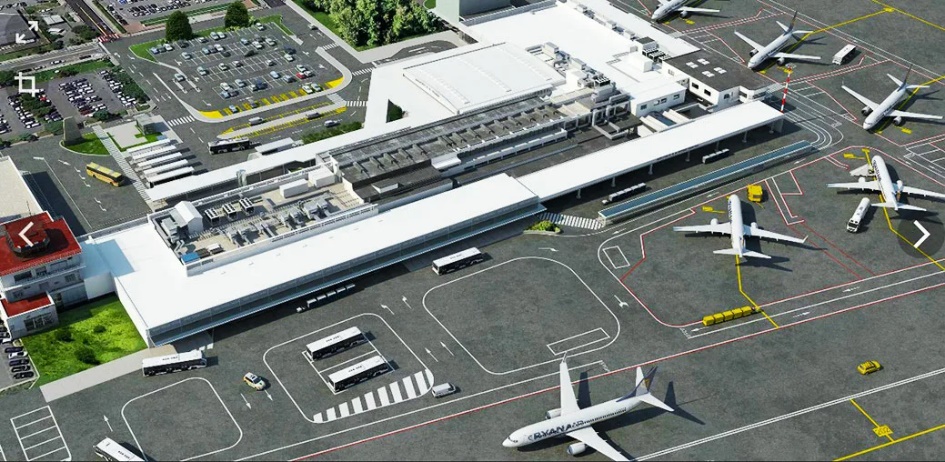
Addition 4
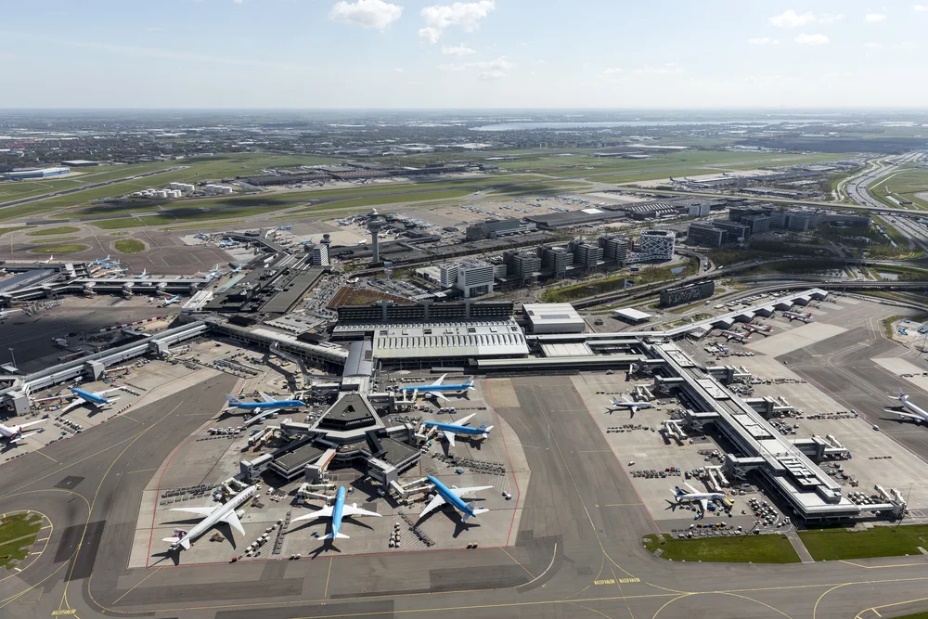
Addition 5
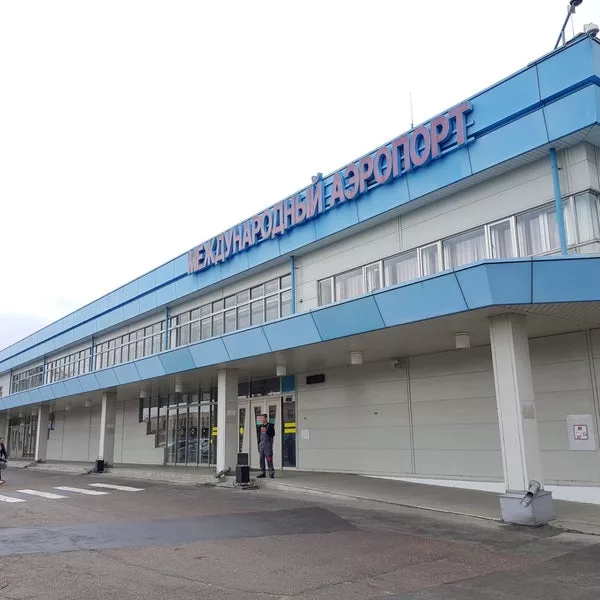
Addition 6
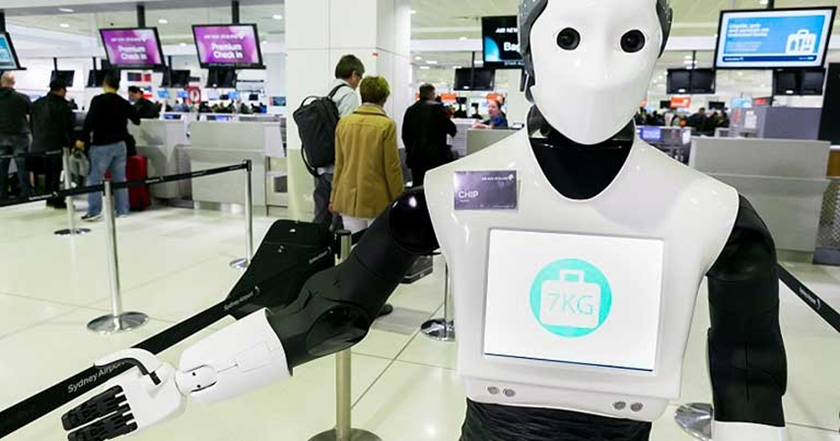
Addition 7

































